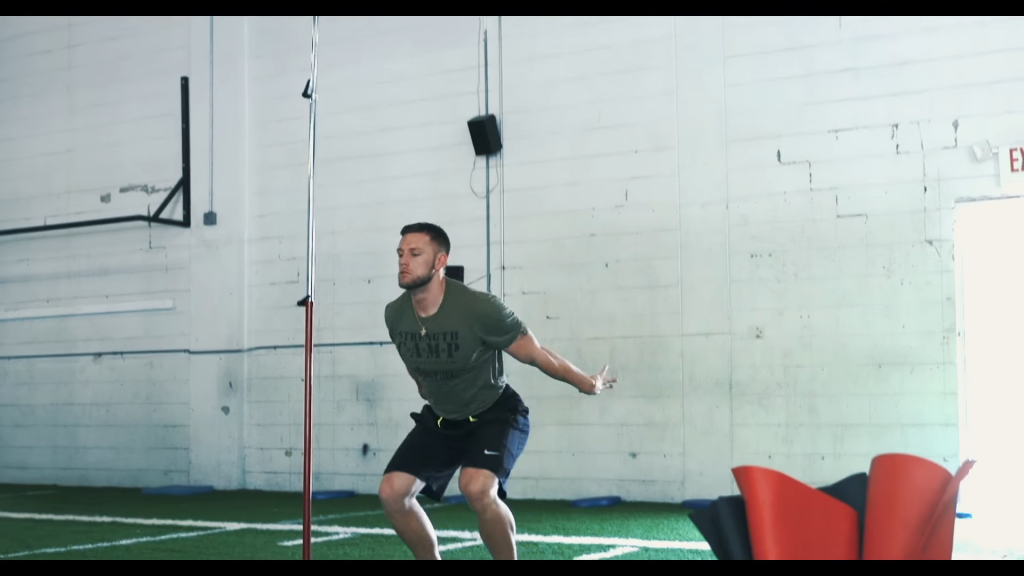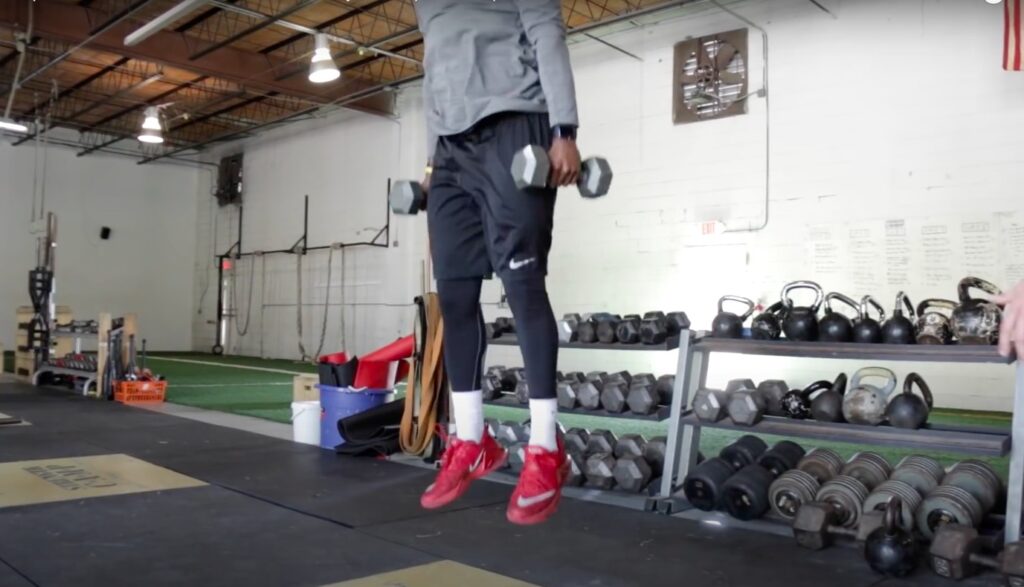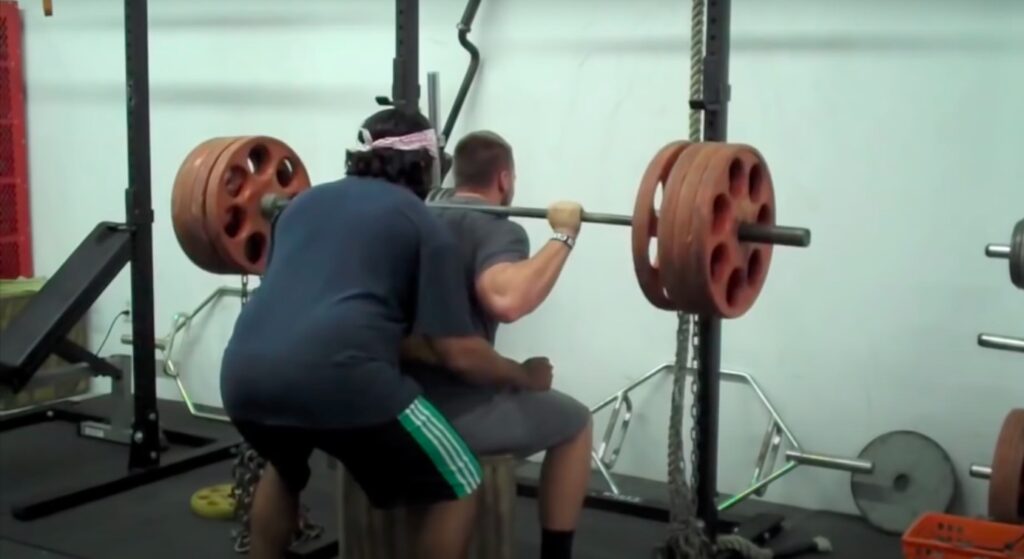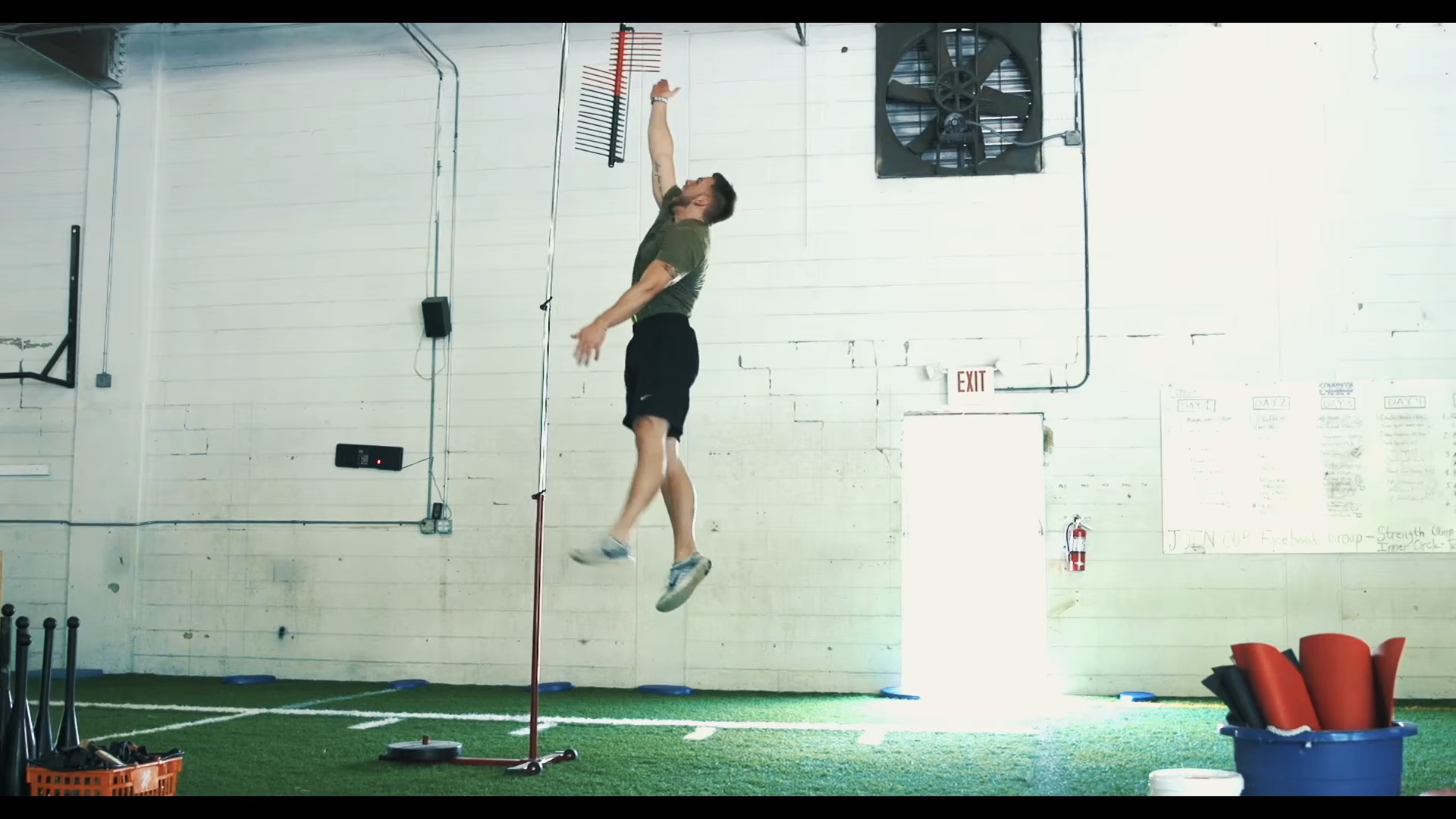No matter what sport you play, training to increase your vertical jump will help you become faster and stronger on the court or field.
While a strong vertical requires a lot of technique and power, athletes have tons of options in how they may train for it.
Throughout my career I’ve found that these exercises always give my athletes the best results, through building overall explosiveness and power.
So are you ready to get your jumps up? Keep reading… coming up are my top five best drills to increase your vertical jump.

TOP 5 BEST DRILLS FOR VERTICAL JUMP
1. RHYTHM DUMBBELL SQUAT JUMPS

- Grab a set of heavy dumbbells, one in each hand and begin in an upright, standing position.
- Keeping the core tight and the spine straight, sink the hips back and down until you reach a quarter squat position.
- Drive into your feet and power up into the air as high as you can jump.
- Land back into the quarter squat position with the feet flat and your weight sitting back into the heels.
I like to add in the rhythm component here because it ends up giving my athletes a few more reps than usual.
Doing this helps to recruit additional motor patterns even as the body begins to fatigue. Performing more reps, the posterior chain is forced to turn on new motor units and learns to adapt.
In this drill, I’m looking for the athlete to spend the least amount of time on the ground. You’re going to sink the hips back and down coming into a quarter squat similar to your vertical.
This allows you to produce greater force and have more air time.
2. MED BALL POWER TOSS

- Begin holding a med ball with both hands in front of your hips.
- Keeping the spine flat and the core tight, get into a rhythm by pushing the hips back and hinging at the waist.
- Start going through the movement by bringing the med ball down between the knees (without the overhead toss yet) to make sure that the glutes are warmed up.
- When you’re ready, you’ll simultaneously drive the hips forward and bring the arms and med ball straight up overhead, throwing the ball up and back.
Make sure the glutes are warmed up for this one.
The entire posterior chain is responsible for producing the force necessary to launch the med ball back as far as possible behind you.
This is an awesome ballistic movement that teaches the body to overpower a load and explode by producing lots of force. It mimics how you’d move in a vertical jump, except here you’re releasing the actual weight of the med ball.
3. REBOUND VERTICAL JUMP


- Begin by standing on a bench or platform about 20inches off the ground in front of a vertical jump test stick.
- Step off the platform to land on the ground in a quarter squat position with flat feet and a straight spine.
- As you touch the ground, immediately swing both arms over your head and jump up to touch the sticks for your vertical.
When it comes to plyometrics, it’s proven that the most effective way to train and improve jump skills is having an athlete initially jump down off a platform.
Over-time, athletes can absorb greater force in their muscles and tendons which translates over to jumping ability.
I love this exercise for how it helps an athlete develop more power and resilience. It’s also great to simply work on your technique for increasing your vertical jump.
4. HIGH BOX SQUAT

- With a plyometric box about 20 inches tall behind you, set up for a barbell squat.
- With the barbell on your shoulders, unpack the bar and begin walking backward in front of the box
- Line your feet up so that your heels are close to touching the box.
- Standing up tall and keeping the spine straight, sit the hips back and down into a squat until you sit on top of the box.
- Drive through your heels to come up to standing.
This is one of my all time favorite lower body lifts for strength and performance. The high box squat is an exercise I often used when training for the combine, and it significantly helped to improve my vertical.
This drill requires that you’re able to overcome a great resistance from a static position, hitting a dead stop on the high box.
Why you should HIGH BOX SQUAT:
- You work through a limited range of motion (similar to the vertical jump). Using the high box, your squat hits just below the very point at which you jump from when performing the vertical.
- Next, it allows you to add more intensity to your squat training. The box squat enables you to squat with more weight and therefore increase your absolute lower body power.
- The high box squat is also triphasic nature: covering eccentric, isometric, and concentric movements all in one.
As you lower from standing, your focus is on a controlled eccentric movement under great resistance. This helps to train your stretch reflex.
At the bottom of the squat (when you’re sitting on the box), you reach an isometric/static position. Finally, finish in the concentric phase by standing back up and overcoming the load.
HURDLE JUMP

- Approach the hurdle jump from a few steps away.
- Lowering down into a quarter squat position, jump off of both feet, simultaneously swinging your arms up overhead.
- Jump over the hurdle and land on both feet.
You may think that a standard vert is the best drill to increase your vertical jump… but I love this drill more than any other.
It gets an athlete to compete.
To be honest with you, I find that the hurdle jump is best at teaching an athlete to translate power onto the court or field in addition to the actual vertical jump test.
Why is this?
The hurdle jump teaches you to start moving more dynamically and athletically. It truly bridges the gap between training and sport.
This drill keeps it simple and is definitely my top drill for increasing your vertical jump. Learn to compete day in and day out performing this exercise.
THE MOST EFFECTIVE TRAINING FOR A VERTICAL
When training to increase your vertical, take a full approach by developing technique, adding regular jumps into your training and staying religious about stretching the hip flexors.
A few years back, I was able to increase my own vertical by 12 inches, bringing me to a 44-inch vertical jump.

With the exact methods I used day-in-and-day-out, I developed this precise plan for you to do just the same.
It’s called the Flight System.
And a few years ago, I released it to help athletes all over the world jump higher. Whether they wanted to dunk, catch more passes, or grab more boards, they found success.
So are you ready to finally increase your vertical jump?
Click the link below to read more about how the Flight System works and the impact it’s had on countless athletes
